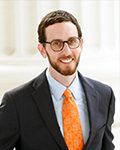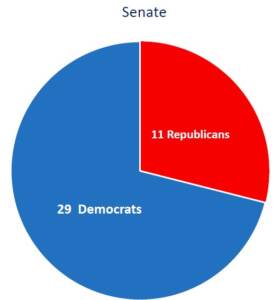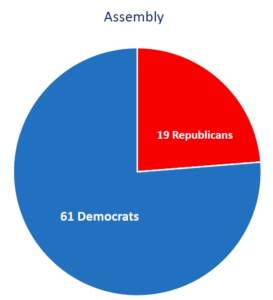The stakes are certainly high this year for California’s rental housing industry.
In 2020, we can expect a radical rent control measure back on the statewide ballot, an emboldened tenants’ movement at the state and local level, and the prospects of another blue wave in the California Legislature.
In the paragraphs below, we’ll explore these and several other important housing issues to watch in 2020.
Proposition 10 2.0 likely headed for ballot
Anti-housing crusader Michael Weinstein and tenant activists are again attempting to return California to the radical rent control policies of the 1970s. Weinstein and other supporters of the Rental Affordability Act submitted signatures last month in hopes of qualifying their measure for the November ballot. The Secretary of State’s office is expected to confirm the qualification.
The proposed statewide ballot measure would weaken the Costa-Hawkins Rental Housing Act, landmark legislation that prevents local jurisdictions from imposing rent control on units built after 1995. Under the proposed statewide ballot, cities and counties would be authorized to impose local rent control ordinances on buildings after they turn 15 years old.

Weinstein’s measure would also allow local governments to apply vacancy controls, meaning rents would remain regulated in rent-controlled jurisdictions even after changes in tenancy.
The proposition would affect rent control laws imposed by cities and counties but would not apply to housing covered by Assembly Bill 1482, the statewide rent cap law that took effect Jan. 1.
This marks the second time Weinstein has used the statewide initiative process to attack Costa-Hawkins. In 2018, he attempted to repeal the law through Proposition 10, which failed miserably at the polls despite his having spent close to $30 million on the campaign. The new measure has been nicknamed Proposition 10 2.0 because of its similarities to its predecessor.
The California Apartment Association is preparing to help lead a campaign to defeat the measure. As with Prop 10, though, stopping Weinstein’s new measure will be costly.
Tenants’ movement to continue in Capitol, locally
Unsatisfied yet emboldened by the passage of AB 1482, the statewide rent cap, tenant groups this year will continue to pursue onerous regulations on the rental housing industry, both at the local level and in the state Legislature.
From a statewide perspective, attacks on the industry will likely include the reintroduction of AB 36 by Assemblyman Richard Bloom, D-Santa Monica. Like Prop 10 2.0, this bill would weaken Costa-Hawkins.

AB 36 would authorize cities and counties to expand local rent control laws to buildings as they turn 10 years old, as well as to single-family homes. Bloom introduced this bill in 2019 but it failed to gain traction and was shelved for the year.

CAA also anticipates another legislative attempt to mandate a statewide rental registry. This will likely come from Assemblywoman Buffy Wicks, D-Oakland, who made a similar attempt last year with AB 724. That bill, which died in the Assembly Appropriations committee, would have created a rental housing registry for all California properties with more than 16 units and carried an initial price tag north of $20 million, with negative privacy implications for both landlords and tenants.
Even though AB 1482 caps rent increases for most California, tenant groups will likely continue to push for local rent control ordinances. These proposals are likely to include just cause provisions that go much further than those in AB 1482. CAA will continue to oppose these types of local laws, which threaten the state’s efforts to address its ongoing housing shortage.
Increased housing supply to emerge as top priority in Legislature
Last year, the state Legislature and governor focused on tenant protections. This year, increasing supply should stand as their top housing priority.

Newsom has set an ambitious goal of adding 3.5 million units by 2025. Meeting that goal will require swift and decisive action in Sacramento.

One meaningful step would be the passage of SB 50 by Sen. Scott Wiener, D-San Francisco. This bill is back after stalling last year and would allow for expedited housing construction near existing job centers and public transportation. This week, Wiener announced amendments to the bill that would give local jurisdictions more latitude in how they fulfill the mandates in SB 50. For example, SB 50 would now give cities two years to adopt their own policies to increase housing near transit and job centers.
The local plans would have to allow the same amount of housing as would SB 50. Cities that fail to submit satisfactory plans by the deadline would have to follow Wiener’s legislation.
As in previous years, CAA will also sponsor legislation this year to expedite housing construction. Details on those proposals will follow in the coming months.
Another blue wave possible in state Legislature

California’s Legislature, as well as its voters, have become increasingly blue – a trend likely continue to continue with the November election.

In California, voter registration has reached about 80%, the highest it’s been since the 1950s; 44.4% are registered as Democrats, 25.1% as Republicans at 25.5 with no party preference. In a presidential election, these political dynamics don’t bode well for the waning number of Republicans in the state Legislature, who already are outnumbered by Democrats by a roughly 3-1 margin. At present, the state Senate has 11 Republicans, compared with 29 Democrats; while the Assembly has 19 Republicans, compared with 61 Democrats.
At this stage, four Republicans in each house face significant Democratic challengers. Some moderate Democrats also are at risk of losing their seats to more left-leaning challengers.
In the coming months, CAA and its political-action arm, CAAPAC, will be working to elect state representatives who, regardless of political affiliation, appreciate the important role that rental housing providers play.
More states of emergency and price gouging protections?
At the end of 2019, Gov. Newsom extended fire-related protections against price gouging, including rent increases above 10%, for several counties — Butte, Los Angeles, Mendocino, Napa, Santa Barbara, Sonoma and Ventura. These protections extend through the end of 2020. Given California’s recent experiences with wildfires, further declarations may come this summer and fall.
The protections against price gouging after fires and other disasters come from Penal Code Section 396, which served as the inspiration for California’s new rent cap law, AB 1482.

It’s important to note, however, that unlike AB 1482, which caps rent increases on a yearly basis, price gouging protections under Penal Code Section 396 remain in effect for the duration of the emergency or proclamation. In Napa County, for example, protections have been in place since the Wine Country fires of fall 2017.
“Another key difference is that many types of property are exempt from AB 1482,” said Debra Carlton, executive vice president of public affairs for CAA. Under AB 1482, non-corporate owned single-family homes and units built within the past 15 years are exempt. The 10% cap under a state of emergency, though, applies to all housing types regardless of age – and remains in effect during vacancies.

